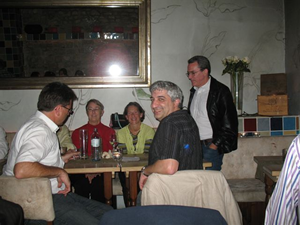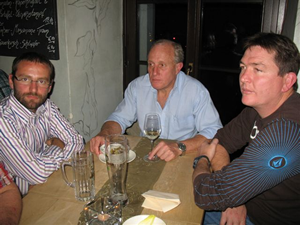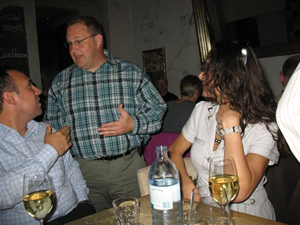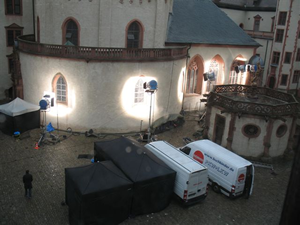 |
Day three in Würzburg, Germany now and day two of two for the 3rd International Conference on Geosynthetic Clay Liners. Registration has risen to just under the magic 100 mark, and interestingly it includes about 13 GCL manufacturers.
The Three Musketeers production, which was being filmed on location around the conference site here at the historic Fortress Marienberg, has moved on.
Patrick Fox’s (UCSD, USA) keynote paper started off the day with an overview of direct shear testing and the absolute need to use actual site materials for testing. Then, what displacement rate to use (the optimum not yet being defined) and when to use peak or residual strength values. The shear rate is important because it can impact the failure mode.
Helmut Zanzinger discussed shear tests on stitch-bonded GCLs over a range of temperatures using demineralized water to avoid cation exchange.
Next up, Werner Müller described how the use of tap water with its associated ion exchange process formed a "composite bentonite/geotextile/stitching" structure that had significantly higher shear strengths than the original Na bentonite GCL. Pre-oxidation has little effect on the strengths at soil cover layers exceeding 1 m. This must be the first time we have heard of cation exchange being beneficial! Discussion emphasized the fact that the GCL resulting from cation exchange of Na by Ca is not the same as, but has lower hydraulic conductivity than, an original Ca bentonite GCL.
Sam Allen (TRI, USA) highlighted the need to consider out-of-plane deformation in puncture tests, stating that some feel the best puncture resistance is demonstrated by high deformation while others think puncture strength is more important. Clearly both parameters have their place. He showed the puncture protection afforded by a GCL on the performance of a high-density polyethylene (HDPE) geomembrane, with deformation being assessed from 3-D images generated by new laser profilometry equipment.
It’s important to note that Sam was not proposing the primary use of a GCL as a protection layer.
 |
 |
Both Mike Heibaum (BAW, Germany) and K. Werth (BBG, Germany) discussed the installation and performance of GCL canal liners deployed underwater. In canal water, full cation exchange takes 3 or 4 years to occur.
Kent von Maubeuge (Naue, Germany) compared the "greenness" of GCLs and compacted clay liners (CCLs) and showed that the energy demand for a typical GCL installation is about 71 MJ/m2 while that for a CCL is 122 MJ/m2. CO2 emissions are 4 and 10 kg/m2 respectively.
Ennio Palmiera (University of Brasilia, Brazil) reported on the addition of sand, clay, and tire particles (<1 mm) in the bentonite of a GCL, finding little effect up to concentrations of 50%.
Finally, Peter Davies (Kaytech, South Africa) reviewed the new GIGSA 1200W recommended standard for needle-punched GCLs.
After a full day of discussion, those who were capable descended on a bar/restaurant for typical German food, beer, and wine. It was an international celebration, with countries represented at the final blow-out being Germany, Turkey, Poland, Canada, USA, South Africa, and France.
 |
 |
A fantastic conference, truly, and quite well-organized by Helmut Zanzinger and Irina Bender of SKZ. The excellent technical presentations were reviewed by Helmut, Nathalie Touze-Foltz (Cemagref, France), and Bob Koerner (Geosynthetic Institute, USA). We missed Bob, who was unable to attend.
Get ready for the 4th International Conference on Geosynthetic Clay Liners in 2018!
For Ian Peggs’ report of his arrival in Würzburg, Germany for the 3rd International Conference on Geosynthetic Clay Liners and his visit to the SKZ laboratory, see this article. See also, Day 2’s report.
Ian D. Peggs is president of I-CORP International. He can be reached at icorp@geosynthetic.com.











